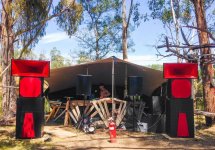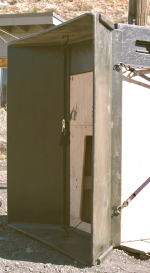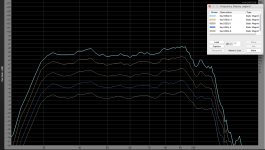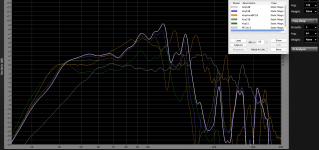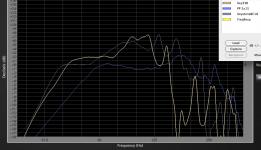"Hope it will solve the walking subs!"
PPSL mounting makes for subs that do not walk.
True, but it does make a tapped horn a rather more difficult build.
Chris
The rubber pads should do the trick, if not reverse the polarity of the system every so often, and it should dance back to where it was originallyI was just out and bought a package of the stone rubber feet, but they are small, 60x90 mm. Still much bigger surface than my current feet offcourse!
Hope it will solve the walking subs!

Art
I had the same problem with TH18 prototype standing up. First I did some more bracing and then I put some 'stone carriers' (rubber plates from recycled rubber) that helped a lot. i think you can find them at your local BAUHAUS Bäckebol. We use this a lot on our gigs. looks like this:
Hi there: Here in the US we can purchase similar recycled rubber pads at HomeD in 18"x18" and 18"x 9" in the garden department, at a rather reasonable cost. Ollie's also carries the 18"x18" size. Also, I've used them for no/low resonance OB driver boards...regards, Michael
Have you tried raising the back of the sub with a strip of wood say about 1/2" high? Let the front edge of the sub rest on the ground. This should decouple the bottom panel from the ground and remove its vibrations as a cause of the "movement".
The subs are already decoupled from the ground using common rubber feet like for cases and such. But as usual the feet have a rather small area which might be the issue.
My old MTL1s never walked. They had large feet AND they were very soft. These look very similar. https://www.parts-express.com/penn-elcom-9106-rubber-cabinet-foot-25-dia-x-1-h--260-772
This weekend we ran this warehouse party with dark techno using two keystones with extenders.
Hey I'm about to build some extenders for mine, do you cross brace yours or is it not needed, also do you notice much difference with the extender? I know Art measured a 3db increase.
Hey I'm about to build some extenders for mine, do you cross brace yours or is it not needed, also do you notice much difference with the extender? I know Art measured a 3db increase.
Hi there! Not sure what you mean with cross bracing, I use no bracing at all, three straps each extender and it works like a charm.
Yes there are a difference, especially regarding a comment Art made that they are actually lower close up and the increase are at about 2 meters distance to the cabs.
Not sure I think they are worth it, if it was louder even close up would be better in my book. I would probably take the time to build more keystones instead in the aftermath.
Last edited:
Hi there! Not sure what you mean with cross bracing, I use no bracing at all, three straps each extender and it works like a charm.
Yes there are a difference, especially regarding a comment Art made that they are actually lower close up and the increase are at about 2 meters distance to the cabs.
Not sure I think they are worth it, if it was louder even close up would be better in my book. I would probably take the time to build more keystones instead in the aftermath.
I mean putting horizontal and vertical bracing in the extender to increase structures integrity and reduce resonance the extenders might create. Hmmmm maybe I build 2 more each side but it's a considerable cost to ship the parts to Australia and then power them. I'm currently running them off a bridged MC2 ti1500 that puts out 3000watt at 4ohmes and don't want to spend more on Amos because they are really $$ here.
I have some spare ply so might give it a go.
Anyway thanks for your input
Rowan
Attachments
Rowan,I'm currently running them off a bridged MC2 ti1500 that puts out 3000watt at 4ohmes and don't want to spend more on Amos because they are really $$ here.
I have some spare ply so might give it a go.
Rowan
The wave guides are in a relatively low pressure zone compared to the exit, so don't require the bracing the cabinet requires. That said, the diagonally cut 2x4 lumber bracing at the mouth does do a fair amount of bracing.
On the one hand, three dB more output does not seem huge, but on the other hand, having the equivalent of double the amplifier power with no power compression can be a huge deal, especially when mains power is limited.
Art
Attachments
"especially when mains power is limited."
+1
Trying to pull 120A and the drop from the pole is only 8ga (most going to the AC and beer coolers).
+1
Trying to pull 120A and the drop from the pole is only 8ga (most going to the AC and beer coolers).
Gday all
I am planning on building a pair of keystones. To get my head in the game I decided to redraw the plans in cad. As I was doing so it seemed to make sense to round a few of the measurements on the pieces that need cutting - from fractions of a mm to something a bit easier to work within the shed.
The first draft is attached, I thought I could get input and post the final DWGs for all to use.
Most measurements are within 3mm of their inch equivalents. The only exception is the horn top (small piece above driver) which is 80mm as compared to 73 in the original drawings. Thing is I can't keep the angles of the horn pieces and the clearances at each end AND get this smaller without reducing the cabinet size.
Does anyone think this will have a meaningful impact on the performance of the unit?
I am planning on building a pair of keystones. To get my head in the game I decided to redraw the plans in cad. As I was doing so it seemed to make sense to round a few of the measurements on the pieces that need cutting - from fractions of a mm to something a bit easier to work within the shed.
The first draft is attached, I thought I could get input and post the final DWGs for all to use.
Most measurements are within 3mm of their inch equivalents. The only exception is the horn top (small piece above driver) which is 80mm as compared to 73 in the original drawings. Thing is I can't keep the angles of the horn pieces and the clearances at each end AND get this smaller without reducing the cabinet size.
Does anyone think this will have a meaningful impact on the performance of the unit?
Attachments
David,Gday all
I am planning on building a pair of keystones. To get my head in the game I decided to redraw the plans in cad. As I was doing so it seemed to make sense to round a few of the measurements on the pieces that need cutting - from fractions of a mm to something a bit easier to work within the shed.
The first draft is attached, I thought I could get input and post the final DWGs for all to use.
Most measurements are within 3mm of their inch equivalents. The only exception is the horn top (small piece above driver) which is 80mm as compared to 73 in the original drawings. Thing is I can't keep the angles of the horn pieces and the clearances at each end AND get this smaller without reducing the cabinet size.
Does anyone think this will have a meaningful impact on the performance of the unit?
The horn top is the most critical dimension in the entire cabinet, don't expand it. You also expanded the second most critical dimension, the width between the baffle and the horn, don't do that.
Changing any of the other dimensions a few MM won't be a problem.
After a 3/4" (18mm) rounding, there is hardly any material left of a 9mm "rebate", not a good choice for survival on the road.
The rebates on the top of the Keystone exit panel make no sense at all to me.
Cheers,
Art
David,
The horn top is the most critical dimension in the entire cabinet, don't expand it. You also expanded the second most critical dimension, the width between the baffle and the horn, don't do that.
Changing any of the other dimensions a few MM won't be a problem.
After a 3/4" (18mm) rounding, there is hardly any material left of a 9mm "rebate", not a good choice for survival on the road.
The rebates on the top of the Keystone exit panel make no sense at all to me.
Cheers,
Art
Good to know I’ll adjust. I have seen a 3” measurement and 2.8” for the horn top. What’s the best?
Also the width between the baffle and horn I have also seen in the various plans as 4” and 3.75”. What’s best do you think?
As stated in the OP, "corrected plans are available in post # 487", use the dimensions from those plans to have yours be the same as the original design, which still is the "best" ;^).Good to know I’ll adjust. I have seen a 3” measurement and 2.8” for the horn top. What’s the best?
Also the width between the baffle and horn I have also seen in the various plans as 4” and 3.75”. What’s best do you think?
Keystone B-Low
After two hurricanes since purchasing the plywood, am well on the way to completion of the six Keystone “B-Low” cabinets that I hoped to start on about a year ago, before life got messy, then slowly cleaned back up.
With changes in latitudes, attitudes and computer operating systems that have fell by the wayside like rotten bamboo scaffold in the tropics, the Smaart measuring system used for all the 2011 and subsequent tests now is problematic.
To compare prior test results to the new sub designs has been like pulling teeth, it feels better after, but then there are those gaps..
The 4.5” taller Keystone B-Low is a “qualified success”.
According to simulations, the longer path length should have dropped the Fb (the minimum excursion point for the driver) to 29.65 Hz, with an F3 of 31 Hz.
It did not. The first test using an exit of 416 square inches had a 35 Hz Fb.
Reducing the exit to 267 square inches dropped Fb to 34 Hz, and reduced excursion around Fb. With a 207 square inch exit, the Fb drops to 33 Hz, increasing available output at 31 Hz (the “Low B” note) by 2 dB over the 34 Hz version.
In addition to the Fb not being as low as expected, the LF corner is higher than the original design, perhaps due to the BC18TBW-4 having less BL than the more expensive, higher BL, higher power, (but less sensitive) BC SW18115-4 used in the original.
The original BC18SW115-4 Keystone excursion minima (Fb) is about 34 Hz, with -8 dB response at 30 Hz. It’s excursion is the same at 32 Hz as 45 Hz.
The Keystone B-Low with a 207 sq. in exit has a 33 Hz Fb, -10 dB at 30Hz response, but with equivalent excursion at 23 & 42 Hz. This wider range of excursion control allows a 12 dB LF EQ boost to the BCTBW100-4 at 92 volts, with only 16% distortion, compared with 32% in the original at 77 volts. From 35 Hz to 100 Hz distortion averages only 3% at the same 124 dB output level.
Since the original expectation of a F3 of 31 Hz with a resultant overall sensitivity drop did not occur, Hoffmann’s Iron Law prevailed. The “B-Low”, being larger, but with nearly the same Fb as the original Keystone is a bit more sensitive over most of the pass band. The larger box with a longer horn path can accept more voltage around Fb with less than half the distortion, so can produce more “gut feel”. The upper output range is huge, real world peaks in the 133 dB SPL range above 40 Hz are no problem, at 100 Hz around 145 dB SPL seems to be available based on initial testing.
Two channels of a NU4-6000 bridged mono used for testing produces as much as 3000 watts at clip/limit. The limiter is hard, no audible clipping is heard, but if the light flashes even momentarily, the input/output is reduced by 1 dB. This can be seen in the Keystone B-Low screen shot Key33EQ -6 to +6 tests. Regardless of input level increases, once the limiter engages, output will not raise at all.
The Keystone B-Low was swinging 116-118 dB SPL peaks at 2 meters with "bottom feeder" type music like Bass Mekanik's “Bass I Love You” tickling the limiters when equalized flat to 30 Hz, requiring a 12 dB boost at 30 Hz. 92 volts of juice swinging down there!..
Raising the HP from 25 to 30.5, effectively eliminating the LF boost in the pass band brought SPL to 124 dB or more with more typical rock fare. That level is equivalent to 130 dB musical peaks at one meter with a typical SPL meter “C” scale, fast response. “Fast” is still slow compared to short peaks not visible on the old analog SPL meters used.
The initial listening test ended abruptly when a neighbor came over with complaints of her windows rattling and chest hurting. The nearest part of her house is 171 feet (52.6 meters) from the speaker location. I was already feeling a little queasy from the 30 Hz response from the first couple songs played, and at over 25’ from the sub could feel the louder rock bass line modulating my voice on each note while I apologized to her and shut down.
Although I am happy with the response of the Keystone B-Low for the type of music I prefer to work with, if heavy output below 40 Hz is what you are looking for, Josh Ricci’s Othorn, Gjallerhorn, or Skhorn are still the way to go if you can afford it.
In the screen shots below, “KeystoneBC18” is the original using a BC18SW115, the various “Key” show response of various exit openings. “PP 2x15” is a cabinet half the size of the original Keystone, details here:
http://www.diyaudio.com/forums/subw...using-dayton-pa385-8-drivers.html#post3898842
I will be testing the Dayton PA 385 in the Keystone B-Low after completing the first pair loaded with the BCTBW100-4.
After two hurricanes since purchasing the plywood, am well on the way to completion of the six Keystone “B-Low” cabinets that I hoped to start on about a year ago, before life got messy, then slowly cleaned back up.
With changes in latitudes, attitudes and computer operating systems that have fell by the wayside like rotten bamboo scaffold in the tropics, the Smaart measuring system used for all the 2011 and subsequent tests now is problematic.
To compare prior test results to the new sub designs has been like pulling teeth, it feels better after, but then there are those gaps..
The 4.5” taller Keystone B-Low is a “qualified success”.
According to simulations, the longer path length should have dropped the Fb (the minimum excursion point for the driver) to 29.65 Hz, with an F3 of 31 Hz.
It did not. The first test using an exit of 416 square inches had a 35 Hz Fb.
Reducing the exit to 267 square inches dropped Fb to 34 Hz, and reduced excursion around Fb. With a 207 square inch exit, the Fb drops to 33 Hz, increasing available output at 31 Hz (the “Low B” note) by 2 dB over the 34 Hz version.
In addition to the Fb not being as low as expected, the LF corner is higher than the original design, perhaps due to the BC18TBW-4 having less BL than the more expensive, higher BL, higher power, (but less sensitive) BC SW18115-4 used in the original.
The original BC18SW115-4 Keystone excursion minima (Fb) is about 34 Hz, with -8 dB response at 30 Hz. It’s excursion is the same at 32 Hz as 45 Hz.
The Keystone B-Low with a 207 sq. in exit has a 33 Hz Fb, -10 dB at 30Hz response, but with equivalent excursion at 23 & 42 Hz. This wider range of excursion control allows a 12 dB LF EQ boost to the BCTBW100-4 at 92 volts, with only 16% distortion, compared with 32% in the original at 77 volts. From 35 Hz to 100 Hz distortion averages only 3% at the same 124 dB output level.
Since the original expectation of a F3 of 31 Hz with a resultant overall sensitivity drop did not occur, Hoffmann’s Iron Law prevailed. The “B-Low”, being larger, but with nearly the same Fb as the original Keystone is a bit more sensitive over most of the pass band. The larger box with a longer horn path can accept more voltage around Fb with less than half the distortion, so can produce more “gut feel”. The upper output range is huge, real world peaks in the 133 dB SPL range above 40 Hz are no problem, at 100 Hz around 145 dB SPL seems to be available based on initial testing.
Two channels of a NU4-6000 bridged mono used for testing produces as much as 3000 watts at clip/limit. The limiter is hard, no audible clipping is heard, but if the light flashes even momentarily, the input/output is reduced by 1 dB. This can be seen in the Keystone B-Low screen shot Key33EQ -6 to +6 tests. Regardless of input level increases, once the limiter engages, output will not raise at all.
The Keystone B-Low was swinging 116-118 dB SPL peaks at 2 meters with "bottom feeder" type music like Bass Mekanik's “Bass I Love You” tickling the limiters when equalized flat to 30 Hz, requiring a 12 dB boost at 30 Hz. 92 volts of juice swinging down there!..
Raising the HP from 25 to 30.5, effectively eliminating the LF boost in the pass band brought SPL to 124 dB or more with more typical rock fare. That level is equivalent to 130 dB musical peaks at one meter with a typical SPL meter “C” scale, fast response. “Fast” is still slow compared to short peaks not visible on the old analog SPL meters used.
The initial listening test ended abruptly when a neighbor came over with complaints of her windows rattling and chest hurting. The nearest part of her house is 171 feet (52.6 meters) from the speaker location. I was already feeling a little queasy from the 30 Hz response from the first couple songs played, and at over 25’ from the sub could feel the louder rock bass line modulating my voice on each note while I apologized to her and shut down.
Although I am happy with the response of the Keystone B-Low for the type of music I prefer to work with, if heavy output below 40 Hz is what you are looking for, Josh Ricci’s Othorn, Gjallerhorn, or Skhorn are still the way to go if you can afford it.
In the screen shots below, “KeystoneBC18” is the original using a BC18SW115, the various “Key” show response of various exit openings. “PP 2x15” is a cabinet half the size of the original Keystone, details here:
http://www.diyaudio.com/forums/subw...using-dayton-pa385-8-drivers.html#post3898842
I will be testing the Dayton PA 385 in the Keystone B-Low after completing the first pair loaded with the BCTBW100-4.
Attachments
According to simulations, the longer path length should have dropped the Fb (the minimum excursion point for the driver) to 29.65 Hz, with an F3 of 31 Hz. It did not. The first test using an exit of 416 square inches had a 35 Hz Fb. Reducing the exit to 267 square inches dropped Fb to 34 Hz, and reduced excursion around Fb. With a 207 square inch exit, the Fb drops to 33 Hz, increasing available output at 31 Hz (the “Low B” note) by 2 dB over the 34 Hz version.
That's a pretty significant difference in predicted vs. actual Fb there. Hornresp predictions for Fb are usually pretty close, though of course the Hornresp prediction is also impacted by the size of the mouth. My guess is that the actual effective path length is not the same as the sim due to the location, size and shape of the mouth.
What is the net volume of the B-Low BTW?
The initial listening test ended abruptly when a neighbor came over with complaints of her windows rattling and chest hurting. The nearest part of her house is 171 feet (52.6 meters) from the speaker location. I was already feeling a little queasy from the 30 Hz response from the first couple songs played, and at over 25’ from the sub could feel the louder rock bass line modulating my voice on each note while I apologized to her and shut down.
LOL..
I will be testing the Dayton PA 385 in the Keystone B-Low after completing the first pair loaded with the BCTBW100-4.
I'd measure the t/s params of those particular Dayton drivers before building anything for them. There have been one or two experiences shared on this form where measured specs were quite a bit off from the published ones.
I'd measure the t/s params of those particular Dayton drivers before building anything for them. There have been one or two experiences shared on this form where measured specs were quite a bit off from the published ones.
Interesting.
The ones I bought a few years ago were spot on. QC slipping?
Interesting.
The ones I bought a few years ago were spot on. QC slipping?
http://www.diyaudio.com/forums/subw...-engineering-sim-tham15ds-15.html#post4587090
Brian,That's a pretty significant difference in predicted vs. actual Fb there. Hornresp predictions for Fb are usually pretty close, though of course the Hornresp prediction is also impacted by the size of the mouth. My guess is that the actual effective path length is not the same as the sim due to the location, size and shape of the mouth.
What is the net volume of the B-Low BTW?
I'd measure the t/s params of those particular Dayton drivers before building anything for them. There have been one or two experiences shared on this form where measured specs were quite a bit off from the published ones.
I already have the four Dayton drivers and four B-Lows that they will go in- sims came out pretty close for the PPSL 2x15" they are loaded in now, so I expect they will work reasonably well, should know how well in a few more days.
The Fb not dropping with the longer B-Low path length is a real mystery, I can't think of any reason why it wouldn't.
The 49.5" x 26.5" x 22.5" B-low is about 370L net, compared to the original 45" x 26.5" x 22.5" Keystone at 337L net.
During the iterative process of choosing the mouth location was surprised to find a rather large range of placement options had little effect on response. For the same Fb, a larger exit is possible towards the cabinet bottom than up by the speaker, but sensitivity stays much the same in either case, although there is a big loss dropping from 33 to 31 Hz.
To maintain cool air flow, and make it easy to monitor the driver heat, I decided to keep the exit high, but did experiment with split exits of various upper and lower area before finding the reduced area carried higher had no negative side effects, and increases cool air flow.
The 49.5" x 26.5" x 22.5" B-low is about 370L net, compared to the original 45" x 26.5" x 22.5" Keystone at 337L net.
Given that net box volume, I was able to come up with a singe-expansion TH for the 4 ohm version of the 18TBW100 that can fit in it with an Fb of 30 Hz and mouth area of 1820 cm^2 (282 sq.in.). With suitable cone compensation, the response of the TH is basically flat from 100 Hz down to Fb. Path length is around 339.4 cm and compression ratio is 2.23. Passband SPL is about 100dB/2.83V/1M.
That your Fb is higher than that with a smaller mouth size for the same volume, AND you had to apply 12dB of boost at 30 Hz to flatten its response is very strange, indeed.
If you want, I can provide a panel list to an MTH-30 type of layout for the TH I described above. If anything, it can be useful for comparison purposes.
- Home
- Loudspeakers
- Subwoofers
- Keystone Sub Using 18, 15, & 12 Inch Speakers
